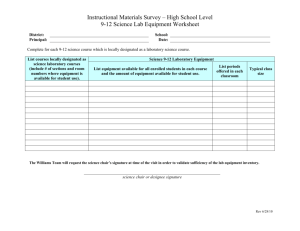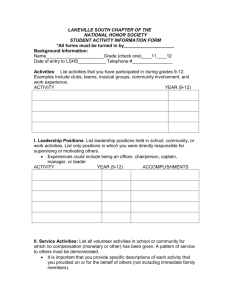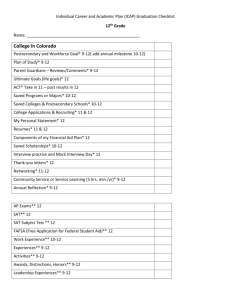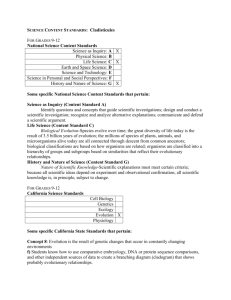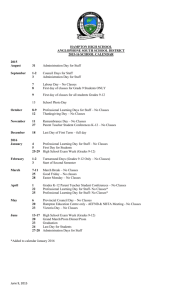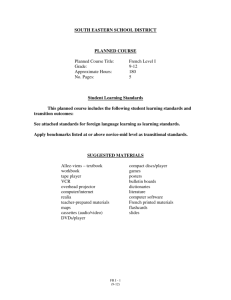CCR Biology - Chapter 10 Practice Quizzes
advertisement
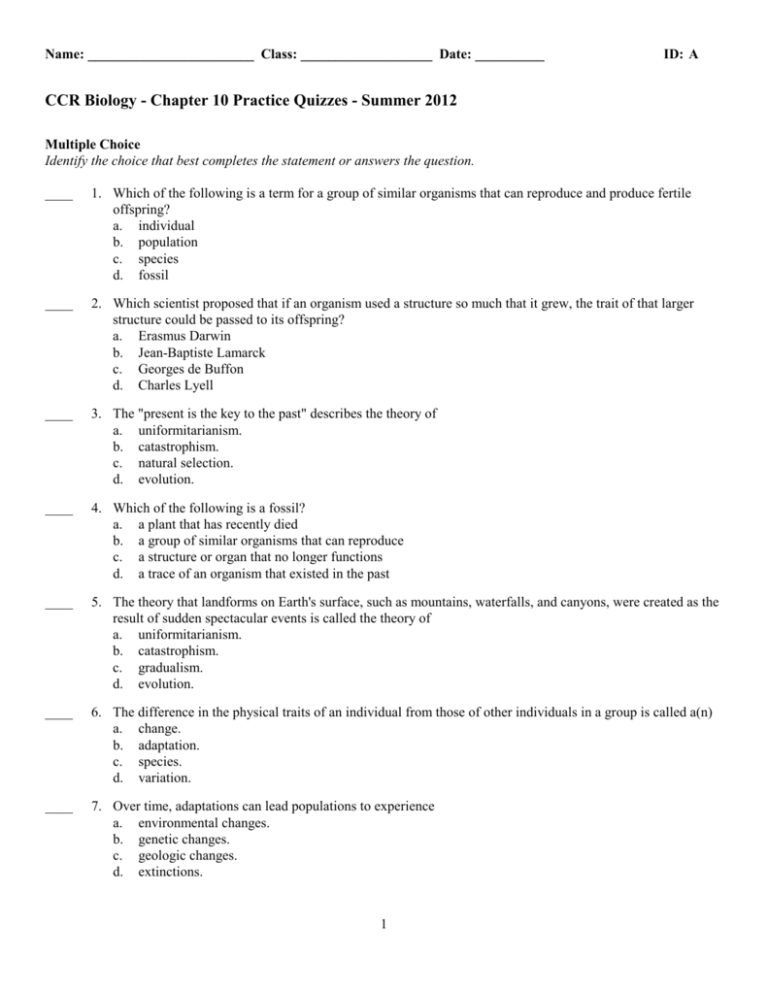
Name: ________________________ Class: ___________________ Date: __________ ID: A CCR Biology - Chapter 10 Practice Quizzes - Summer 2012 Multiple Choice Identify the choice that best completes the statement or answers the question. ____ 1. Which of the following is a term for a group of similar organisms that can reproduce and produce fertile offspring? a. individual b. population c. species d. fossil ____ 2. Which scientist proposed that if an organism used a structure so much that it grew, the trait of that larger structure could be passed to its offspring? a. Erasmus Darwin b. Jean-Baptiste Lamarck c. Georges de Buffon d. Charles Lyell ____ 3. The "present is the key to the past" describes the theory of a. uniformitarianism. b. catastrophism. c. natural selection. d. evolution. ____ 4. Which of the following is a fossil? a. a plant that has recently died b. a group of similar organisms that can reproduce c. a structure or organ that no longer functions d. a trace of an organism that existed in the past ____ 5. The theory that landforms on Earth's surface, such as mountains, waterfalls, and canyons, were created as the result of sudden spectacular events is called the theory of a. uniformitarianism. b. catastrophism. c. gradualism. d. evolution. ____ 6. The difference in the physical traits of an individual from those of other individuals in a group is called a(n) a. change. b. adaptation. c. species. d. variation. ____ 7. Over time, adaptations can lead populations to experience a. environmental changes. b. genetic changes. c. geologic changes. d. extinctions. 1 Name: ________________________ ID: A ____ 8. What did Charles Darwin observe in finch populations on the Galápagos Islands off the coast of South America? a. different species on different islands b. all species on one of the islands c. identical species on all the islands d. the same species as in North America ____ 9. What did Charles Darwin learn from the fossils of a giant armadillo that he found in Argentina? a. An earthquake led to the armadillo's extinction. b. Armadillos used to be marine organisms. c. Modern animals may be related to fossilized organisms. d. Fossils do not resemble modern animals. ____ 10. Fossils of marine organisms high in the Andes Mountains led Darwin to conclude that a. Earth is 6000 years old. b. interspecific variation had taken place. c. great change can happen over time. d. an earthquake had taken place. ____ 11. The development by scientists of a new color in a rose is the result of a. natural selection. b. artificial selection. c. descent with modification. d. overproduction. ____ 12. In natural selection, the selective agent is the a. humans. b. mutations. c. breeders. d. environment. ____ 13. All the rabbits living in a particular area would be an example of a(n) a. population. b. species. c. fossil. d. individual organism. ____ 14. A bird that can easily outcompete other birds for food and that can produce many eggs has a high a. life expectancy. b. mutation rate. c. fitness. d. adaptability. ____ 15. Which of the following describes natural selection? a. It acts on genetic material directly. b. It acts on existing physical traits. c. It forms new traits. d. It forms new genetic material. 2 Name: ________________________ ID: A ____ 16. Which of the following is an example of a vestigial structure? a. the wings of red-tailed hawks b. the hind limbs of a house cat c. the fins of a shark d. the wings of an ostrich ____ 17. Biogeography is the study of the a. distribution of organisms around the world. b. environments around the world. c. different types of rocks around the world. d. age of fossils around the world. ____ 18. What is suggested by the similarity of early embryos of different species of vertebrates? a. no evolutionary relationship between the groups b. recent common ancestry c. similar environments in the past d. evolution from a distant common ancestor ____ 19. Some organisms that share a common ancestor have features that have different functions, but similar structures. These are known as a. vestigial structures. b. analogous structures. c. homologous structures. d. fossil structures. ____ 20. If an organism has a vestigial structure, that structure likely once had a function in a(n) a. close relative. b. early ancestor. c. unrelated organism. d. embryological stage. ____ 21. Paleontology is the study of a. ecosystems. b. genetics. c. fossils. d. rocks and minerals. ____ 22. Two organisms that are closely related would have a. very similar DNA sequences. b. exactly the same DNA sequences. c. no proteins in common. d. completely different DNA sequences. ____ 23. What are pseudogenes? a. cell structures that function like genes b. gene sequences that no longer function c. protein sequences that look like genes d. mutations in nucleotides 3 Name: ________________________ ID: A ____ 24. Evolution is considered to be one of the most important theories in science, because it a. was developed more than 100 years ago. b. is not supported by the fossil record. c. unites the fields of biology, geology, chemistry, and ecology. d. was discovered by Charles Darwin, a famous scientist. ____ 25. Protein sequences in one organism that resemble those of another suggest a a. coincidence. b. lack of evolutionary relationship. c. great number of mutations. d. shared ancestry. 4 ID: A CCR Biology - Chapter 10 Practice Quizzes - Summer 2012 Answer Section MULTIPLE CHOICE 1. ANS: C PTS: 1 REF: act0976aaf18007e13e_33 STA: KY 9-12.4.2.9 | KY 9-12.5.1.2 | KY 9-12.SC-HS-3.4.7.a | KY 9-12.SC-HS-3.4.7.b TOP: 10.1 Quiz NOT: 978-0-618-78317-5 2. ANS: B PTS: 1 REF: act0976aaf18007e13e_41 TOP: 10.1 Quiz NOT: 978-0-618-78317-5 3. ANS: A PTS: 1 REF: act0976aaf18007e13e_49 STA: KY 9-12.5.2.7 TOP: 10.1 Quiz NOT: 978-0-618-78317-5 4. ANS: D PTS: 1 REF: act0976aaf18007e13e_57 STA: KY 9-12.5.2.1 TOP: 10.1 Quiz NOT: 978-0-618-78317-5 5. ANS: B PTS: 1 REF: act0976aaf18007e13e_65 TOP: 10.1 Quiz NOT: 978-0-618-78317-5 6. ANS: D PTS: 1 REF: act0976aaf18007e140_33 STA: KY 9-12.4.1.5 | KY 9-12.4.2.5 | KY 9-12.5.1.3 | KY 9-12.SC-HS-3.5.1.a | KY 9-12.SC-HS-3.5.1.b TOP: 10.2 Quiz NOT: 978-0-618-78317-5 7. ANS: B PTS: 1 REF: act0976aaf18007e140_41 STA: KY 9-12.4.1.4 | KY 9-12.4.1.5 | KY 9-12.5.1.1 | KY 9-12.5.1.3 | KY 9-12.5.2.2 | KY 9-12.5.2.3 | KY 9-12.5.2.5 | KY 9-12.SC-HS-3.5.1.a | KY 9-12.SC-HS-3.5.1.b TOP: 10.2 Quiz NOT: 978-0-618-78317-5 8. ANS: A PTS: 1 REF: act0976aaf18007e140_49 STA: KY 9-12.4.1.5 | KY 9-12.4.2.5 | KY 9-12.4.2.9 | KY 9-12.5.1.1 | KY 9-12.5.1.2 | KY 9-12.5.1.3 | KY 9-12.5.2.2 | KY 9-12.5.2.5 | KY 9-12.5.2.7 | KY 9-12.SC-HS-3.4.7.a | KY 9-12.SC-HS-3.4.7.b | KY 9-12.SC-HS-3.5.1.a | KY 9-12.SC-HS-3.5.1.b TOP: 10.2 Quiz NOT: 978-0-618-78317-5 9. ANS: C PTS: 1 REF: act0976aaf18007e140_57 STA: KY 9-12.5.2.1 | KY 9-12.5.2.7 TOP: 10.2 Quiz NOT: 978-0-618-78317-5 10. ANS: C PTS: 1 REF: act0976aaf18007e140_65 STA: KY 9-12.3.2.10 | KY 9-12.5.2.1 | KY 9-12.5.2.7 TOP: 10.2 Quiz NOT: 978-0-618-78317-5 11. ANS: B PTS: 1 REF: act0976aaf18007e142_33 STA: KY 9-12.7.1.2 | KY 9-12.7.2.5 TOP: 10.3 Quiz NOT: 978-0-618-78317-5 12. ANS: D PTS: 1 REF: act0976aaf18007e142_41 STA: KY 9-12.4.1.5 | KY 9-12.5.1.1 | KY 9-12.5.1.3 | KY 9-12.5.2.2 | KY 9-12.5.2.5 | KY 9-12.SC-HS-3.5.1.a | KY 9-12.SC-HS-3.5.1.b TOP: 10.3 Quiz NOT: 978-0-618-78317-5 13. ANS: A PTS: 1 REF: act0976aaf18007e142_49 STA: KY 9-12.4.1.5 | KY 9-12.5.1.1 | KY 9-12.5.1.3 | KY 9-12.5.2.2 | KY 9-12.5.2.5 | KY 9-12.7.2.4 | KY 9-12.SC-HS-3.5.1.a | KY 9-12.SC-HS-3.5.1.b TOP: 10.3 Quiz NOT: 978-0-618-78317-5 14. ANS: C PTS: 1 REF: act0976aaf18007e142_57 STA: KY 9-12.4.1.5 | KY 9-12.4.2.5 | KY 9-12.5.1.1 | KY 9-12.5.1.2 | KY 9-12.5.1.3 | KY 9-12.5.2.2 | KY 9-12.5.2.5 | KY 9-12.SC-HS-3.5.1.a | KY 9-12.SC-HS-3.5.1.b TOP: 10.3 Quiz NOT: 978-0-618-78317-5 1 ID: A 15. ANS: B PTS: 1 REF: act0976aaf18007e142_65 STA: KY 9-12.4.1.5 | KY 9-12.4.2.5 | KY 9-12.5.1.1 | KY 9-12.5.1.3 | KY 9-12.5.2.2 | KY 9-12.5.2.5 | KY 9-12.SC-HS-3.5.1.a | KY 9-12.SC-HS-3.5.1.b TOP: 10.3 Quiz NOT: 978-0-618-78317-5 16. ANS: D PTS: 1 REF: act0976aaf18007e144_33 STA: KY 9-12.4.1.6 | KY 9-12.4.2.11 | KY 9-12.5.1.2 | KY 9-12.5.2.1 TOP: 10.4 Quiz NOT: 978-0-618-78317-5 17. ANS: A PTS: 1 REF: act0976aaf18007e144_41 TOP: 10.4 Quiz NOT: 978-0-618-78317-5 18. ANS: D PTS: 1 REF: act0976aaf18007e144_49 STA: KY 9-12.4.1.6 | KY 9-12.4.2.11 | KY 9-12.5.1.2 | KY 9-12.5.2.1 TOP: 10.4 Quiz NOT: 978-0-618-78317-5 19. ANS: C PTS: 1 REF: act0976aaf18007e144_57 STA: KY 9-12.4.1.6 | KY 9-12.4.2.11 | KY 9-12.5.1.2 | KY 9-12.5.2.1 TOP: 10.4 Quiz NOT: 978-0-618-78317-5 20. ANS: B PTS: 1 REF: act0976aaf18007e144_65 STA: KY 9-12.4.1.6 | KY 9-12.4.2.11 | KY 9-12.5.1.2 | KY 9-12.5.2.1 TOP: 10.4 Quiz NOT: 978-0-618-78317-5 21. ANS: C PTS: 1 REF: act0976aaf18007e146_33 STA: KY 9-12.3.2.10 | KY 9-12.5.2.1 TOP: 10.5 Quiz NOT: 978-0-618-78317-5 22. ANS: A PTS: 1 REF: act0976aaf18007e146_41 STA: KY 9-12.4.1.4 | KY 9-12.4.1.6 | KY 9-12.4.2.3 | KY 9-12.4.2.6 | KY 9-12.4.2.9 | KY 9-12.4.2.11 | KY 9-12.5.1.2 | KY 9-12.5.2.1 | KY 9-12.SC-HS-3.4.6 | KY 9-12.SC-HS-3.5.1.a | KY 9-12.SC-HS-3.5.1.b TOP: 10.5 Quiz NOT: 978-0-618-78317-5 23. ANS: B PTS: 1 REF: act0976aaf18007e146_49 STA: KY 9-12.4.1.7 | KY 9-12.4.2.3 TOP: 10.5 Quiz NOT: 978-0-618-78317-5 24. ANS: C PTS: 1 REF: act0976aaf18007e146_57 TOP: 10.5 Quiz NOT: 978-0-618-78317-5 25. ANS: D PTS: 1 REF: act0976aaf18007e146_65 STA: KY 9-12.4.1.2 | KY 9-12.4.1.3 | KY 9-12.4.1.6 | KY 9-12.4.2.1 | KY 9-12.4.2.3 | KY 9-12.4.2.6 | KY 9-12.4.2.9 | KY 9-12.4.2.11 | KY 9-12.5.1.2 | KY 9-12.5.2.1 | KY 9-12.SC-HS-3.4.1 | KY 9-12.SC-HS-3.4.3.a | KY 9-12.SC-HS-3.4.3.b | KY 9-12.SC-HS-3.5.1.a | KY 9-12.SC-HS-3.5.1.b TOP: 10.5 Quiz NOT: 978-0-618-78317-5 2 CCR Biology - Chapter 10 Practice Quizzes - Summer 2012 [Answer Strip] A _____ 8. C _____ 1. D 16. _____ C 24. _____ A 17. _____ D 25. _____ C _____ 9. D 18. _____ B _____ 2. C 10. _____ C 19. _____ B 11. _____ A _____ 3. D 12. _____ B 20. _____ A 13. _____ C 21. _____ C 14. _____ A 22. _____ B 15. _____ B 23. _____ D _____ 4. B _____ 5. D _____ 6. B _____ 7. ID: A
